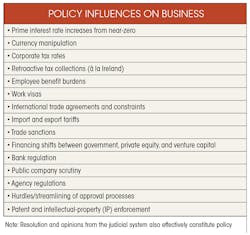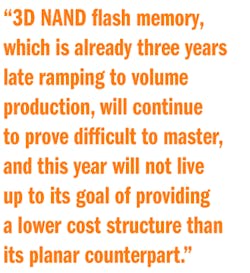How Will Politics Impact the Semiconductor Industry and Overall Business Climate?
This file type includes high-resolution graphics and schematics when applicable.
Some key political events late in 2016 could start having an effect on the electronics and semiconductor industries in terms of the countries where work is performed and finances are attributed. However, the basic mechanisms that drive semiconductor cycles are still very much alive, with under- and over-supplies creating rapid growth and spectacular collapses.
It’s difficult to determine how the overlay of new policy will play out in the near term, so Objective Analysis will apply traditional techniques to forecasting 2017, while pointing out new factors that could cause turbulence in 2017 and coming years. Right now, 2017 promises solid chip revenue growth.
A relatively small portion of the population of Great Britain voted to put greater distance between the country's finances and those of the European Union (EU) in an event referred to as the Brexit referendum. Shortly thereafter and possibly independently, the EU declared that Apple owed Ireland, and therefore the EU, billions in back taxes, saying that Ireland should not have granted exemption over many prior years.
In the United States, real estate mogul Donald Trump was elected President while making numerous dramatic statements that he would bring jobs back to the U.S., keep U.S.-based companies from opening factories elsewhere, and "repatriate" profits to the U.S. with tax and tariff changes. Although the details of such policy and political changes are pretty murky, there’s no doubt that it will impact nations’ economies and corporations’ business. This is against a backdrop of a dubious position of China with a controlling central government and a way of handling business that’s still evolving. In electronics, the automotive, industrial, and consumer industries are likely to be most affected, with semiconductors having to adjust in its own way.
Finance and economics will drive much of the change, which is somewhat unnatural for technology researchers and design engineers who pride themselves on constant improvement in terms of capabilities, performance, and efficiencies. Lower costs typically result from their efforts, resulting in widespread use of technology that betters mankind.
The Path of Least Resistance
Corporations answer not only to their customer base, but also to their stockholders in light of their competitors. Profitability is a benchmark next to market growth judged for each company. This means that the product’s value must be high enough to justify the price to the customer and the cost to build the product—with a proper amortization of the design, development, and software costs.
A few companies hold a special advantage over most, where they can command an unusually high price for their products or services. However, even the rich keep a keen eye on costs while maintaining high quality. But, certainly, most technology companies are scared that another company will take away their customers with a lower-cost offering. Moreover, they’re in a constant struggle to produce their products for as little as possible. Every customer brings higher production volume, which incrementally and directly lowers cost.
The cost without overhead to produce each additional unit is still a significant portion of the total cost allocated to the part. Therefore, the materials, time, and labor to build a batch of parts are regularly reviewed to assure that they’re the lowest possible while keeping quality up to standard. Of course, the cost of the multi-billion-dollar fabs that make semiconductors loads up the burdened part of the cost equation, the errant seed of the quip "we'll make it up in volume."
Silicon Clusters and Sharing
Local entities (states, regions, cities…) often grant tax, utility, and infrastructure concessions or cooperation to attract the construction, engineering, and production jobs associated with high-tech and semiconductor facilities. In addition, the associated support businesses (AMAT, et al), conferences, and highly skilled talent pool and housing that come with a cluster of semiconductor facilities in the area, feeds money and prosperity back to the local community in numerous ways. These exist in many areas, affectionately known as Silicon Valleys, Hills, Glens, Deserts, Prairies, Corridors, and Alleys, where companies large and small take advantage of such concentrations.
Over the past 25 years, the electronics industry has moved from a vertically integrated business model (e.g., Motorola made radios, circuit boards they were made from, and chips the boards were made from) to distinct specialized (horizontal) entities where fabs, packaging, test facilities, distribution, and great quantities of software are individual businesses offering services to many companies under contract.
This lets many companies, large and small, take advantage of leading-edge (or commodity) technologies at low prices without "re-inventing the wheel" with their own research and development (R&D) investments. “Economy of scale” enables many vendors to enjoy the benefits of low cost. In some ways this is considered "the food chain."
Many diverse industries have similar supply-chain scenarios from electronics and automobiles to clothing, construction, and … food. However, high technology is so sophisticated that the relationships and dependencies between partner companies are very intricate and not easily changed.
It turns out that these specialized centers-of-excellence are scattered around the world (as described at http://www.strategysanity.com/extend.html#Regions), but the reasons vary. Often, those locations happen to be where a group of people put great focus on a particular technology or tried a new approach to business, invested appropriately, and partnered with other companies, the stars aligned, and they ended up being successful.
Money Makes the World Go ’Round
All companies are driven by profits, with Wall Street and investors dissecting corporate revenue, growth, outlook, and stock prices in relation to competitors. Continuous scrutiny and quarterly checkpoints force companies to keep their costs down while building value for their product and services to justify higher prices to customers and greater market acceptance.
Deep in the financial formulae for determining product cost are shipping costs and taxes. Moving around subassemblies and partially built product between geographic locations accumulates delays and costs for an enterprise. If those locations are in different cities, states, or countries, then taxes may also be accrued. The shipping costs and taxes offset lower material costs and labor rates in the locales, eroding profits.
Corporations must work within a maze of laws and regulations of the governments and jurisdictions everywhere they operate. When regulations and taxes change, companies must adapt to those changes. Small changes may not force discernable adjustments, but large or immediate changes can have a dramatic effect. Significant changes in taxes and tariffs; import and export limits; government department, agency, or ministry policies; and rulings handed down by courts of law can send companies scrambling to shift their strategies to minimize any financial or market downside.
Government policy changes can have short-term effects—as well as long-term effects that may be harder to foresee. Crushing cars that are deemed "clunkers" may have spurred new car sales in 2009 in the U.S., while car in the streets of Cuba today appear to be locked in a 1960s Twilight Zone episode (but in color). Each situation was caused by a very different governmental intervention.
Few electronic products today are built from the ground up using materials and labor from only one country. Should new regulations, import duties, national pride, or just public shaming make it more costly or difficult to provide goods and services in a locale, then the supply chain could be disrupted, costs could go up, and different companies or products could end up being the winners compared to today's market. That would be simply due to policy changes, not technology advances or better insights to customer needs.
However, frequently there are ancillary effects—often negative—that also disturb the known, if not free, market when policy changes are hastily enacted. Uncertainty and "unintended consequences" can drive the stock prices of affected companies sharply up and down. Such changes also affect the ability of businesses to attract and secure capital investments, which is critical to fast-growing companies in competitive markets.
A Robot in China
It can be argued that starting with the Industrial Revolution, the number of people needed to produce goods has been in decline, somewhat offset by higher wages, and against a background of an increasing population with longer lifespans. As leverage and machines replaced animals, water, steam, electricity, and internal combustion engines as power sources, looms, machinery, and hydraulics took over highly repetitive or possibly dangerous jobs.
Computers and electronics made "knowledge workers" more productive, particularly triggered by the personal computer, productivity software, and personal printers. More recently, digital networking has allowed information sharing and human interaction on a scale and timeframe never seen before, accelerating advancement of ideas and shrinking the world more than what was made possible with aircraft.
Electronic controls have taken over all but the heaviest hydraulic industrial systems in recent years. More connected, intelligent sensors and controllers—the Internet of Things (IoT)—will accelerate the number of electronic devices that can uniquely serve individual humans.
As electronic equipment has become so inexpensive, demand has soared and expanded into purely entertainment and luxury electronics. About 1 billion new mobile phones were bought last year, and there are only 7 billion people on the planet—not all from the U.S. or Europe.
Each of these advances took more people out of the process of getting a product built or a job done, reducing variable costs. But, a robot can build a product in any country for about the same price—it’s only human labor that has a highly variable rate from country to country.
One reason China became a recent leader in manufacturing was due to its large labor force willing to work for wages much lower than required in Europe, the U.S., and Japan. But as automation has increasingly allowed the mass production to reach its current levels, fewer people are necessary in the process. Computer vision and exotic sensors have even eliminated much of the alignment and final inspection that was so dependent on humans many years ago.
As fewer people are part of the manufacturing process, the cost of labor is a smaller portion of the product unit cost, and $50/hour or $5/hour may not be that critical to cost savings. On the other hand, the men and women who do still run and maintain the equipment and construct the building, let alone those who design, lay out, program, and install the custom production line, are highly educated, skilled, and experienced, and their wages can vary greatly, country by country.
2017 May be Pivotal, but Time will Tell
Last year was rife with political rhetoric, often harsh and dramatic. There were governmental agency surprises, sanctions lowered and lifted, judicial proceedings and judgments, currency shifts, protests, shipping strikes, scandals, posturing, laws enacted and softened, referendums, executive orders, tax proposals, accusations, threats, promises, saber rattling, and untold internet drivel. But, usually, specifics were vague.
While recent years have seen much movement on social issues, 2017 may be a pivotal time for business and the resulting economic effects. The electronics industry's primary role in social change has been circulating voices on the internet and airwaves. The intricate balance of the electronics industry will be impacted more directly, as the U.S., the EU, China, and other countries enact policies that revise the rules for doing business, and adjustments will have to be made.
The political machine is messy and typically moves slowly, but that may change with non-politicians at the helm. The effect could be slower than the cause, with long-term ramifications taking years to materialize. But some things may change quickly.
Multi-billion dollar manufacturing plants can't be moved, equipped, and populated in 12 months, even to save 15% that will fall to the bottom line. Logistics, contracts, and qualifications must all be managed, even if the plans are nearly "shovel-ready." However, product shipments to a region can stop "on a dime" (a small, peculiar U.S. coin) when dangerous chemicals are discovered; people are poisoned; cars, skateboards, or computers catch fire; court orders are executed; or tax and regulation changes suddenly take effect. Products caught in limbo may have to be dumped.
If countries start manipulating their currency valuation, interest rates, and trade policies in peculiar ways to pull trade and technology toward them or in response to other countries' actions, and companies scramble to make the best of the changes, it could take years before the ultimate effects prove out. One country's loss becomes another's gain.
As 2017 begins, we may start to see the extent to which political rhetoric, campaign promises, and obscure ideas turn into policies and actions that alter the way businesses operate and make investments. The electronics and semiconductor industry may have to accept some difficult changes.
Objective Analysis Pins Down 2017
For the 2017 semiconductor forecast, Objective Analysis accounted the following as the three most important of the above issues:
• China’s high level of capital spending will not result in significant production capacity in 2017 and not likely make much impact until 2019. When it does, though, it is likely to have a very detrimental effect on chip prices. (A report exploring China’s upcoming role in the memory chip market is coming soon.)
• Much has been said in the U.S. about renegotiating trade agreements and charging “Border Adjustment Taxes” via a “Territorial Tax System” (which appear to be new names for tariffs), and the new administration has promised to encourage tax reform to repatriate U.S. companies’ foreign profits. However, these changes will need to go through legislative processes and corporations will subsequently respond after evaluating the new laws. Likewise, the governments of other countries negatively impacted by such changes will create their own responses to tip the balance back into their own favor. The slow speed of this process implies that very little change, if any, will occur in 2017.
Where the impact is more likely to be felt is in end-user system demand as the change takes a toll on consumer spending. Since many consumer products are made in the Far East, reduced European system demand will translate into lower demand for chips by Asia. This means that any negative consequences of Brexit will be too small to tip the market from its cyclical shortage to an oversupply.
Moore, Memory, Supply and Demand Still Lead Semiconductors
Having accounted for the above, Objective Analysis expects 2017 to be a year of solid growth, forecasting semiconductor revenues to increase by 20%. This is based on the following assumptions:
• Chip prices flatten during a shortage, rather than follow the steady cost decreases that are driven by Moore’s law.
• 3D NAND flash memory, which is already three years late ramping to volume production, will continue to prove difficult to master, and this year will not live up to its goal of providing a lower cost structure than its planar counterpart. This will result in inefficient capacity utilization, culminating in an ongoing shortage.
• To ease the shortage, companies that produce both DRAM and NAND flash may use a portion of their DRAM production capacity to produce planar NAND, driving a sympathetic DRAM shortage.
• Since the memory market accounts for 25% to 35% of total semiconductor revenues, this by itself would cause total semiconductor revenues to increase.
• The NAND/DRAM shortage will be accompanied by tightness in other chips, thanks to a return to health of two key end-user markets: smartphones and PCs.Prices in these non-memory chip markets will also stabilize.
• In semiconductors, short supply causes prices to stabilize, but rarely do prices increase by an appreciable amount. In addition, flat prices fail to cause any short-term decrease in demand. With flat pricing and steady demand growth, chip revenues are destined to rise.
Therefore, Objective Analysis's semiconductor forecast calls for 30% memory revenue growth, driving total semiconductor revenue growth to approach 20%, resulting in total market revenues of $390 billion.
Summary
Corporations will shift design resources, manufacturing, and service hosting to different countries to benefit from major policy changes. However, it will take time to make such changes, or it may be only the new projects that are relocated.
This year will be a year of chip shortages and semiconductor revenue growth, even as the political climate moves toward changes that are likely to suppress that growth over the longer term. Through its solid understanding of chip-market dynamics and the impact of supply and demand on pricing, Objective Analysis is able to confidently predict that chip revenues will approach the $400 billion mark for the first time.
Companies that would like to use the insight and understanding of Objective Analysis to further their goals in the chip market are welcome to make contact through the website.









